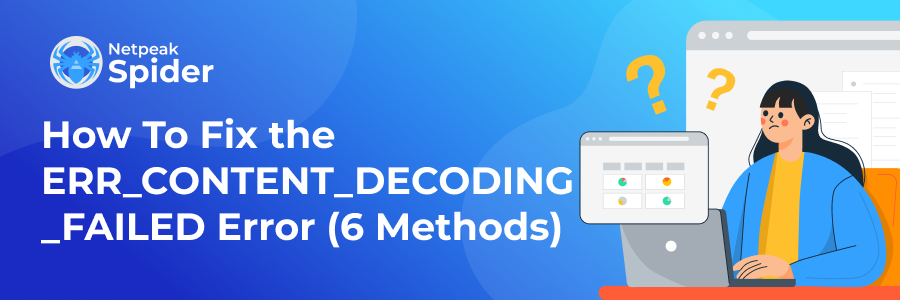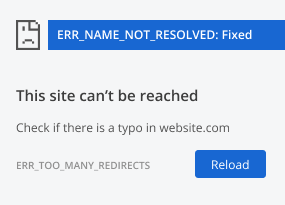Best Ways to Fix the ERR_CONTENT_DECODING_FAILED Error
Site Audit Issues
Browsers like Chrome, Microsoft Edge, and Firefox facilitate web navigation, yet none of them are immune to issues like ERR_CONTENT_DECODING_FAILED, which can occur due to several possible reasons.
This article will reveal the main factors that trigger this issue and the most effective ways to solve it.
What's the ERR_CONTENT_DECODING_FAILED Issue?
While attempting to access a website, the net ERR_CONTENT_DECODING_FAILED error message might pop up; this means users can't view your website. This error is common for browsers like Google Chrome or Safari, and it often depends on the GZIP compression. This compression type is among the easiest ways to optimize a WordPress website.
So, when someone wants to access a website, the browser checks for GZIP compression — it's looking for the content-encoding: gzip response header. When it succeeds, it automatically retrieves the compressed files, decompresses them, and delivers them to a user.
If there are some troubles taking place during this process, you’ll always see the "error while decoding media source" message.
The Main Triggers for the ERR_CONTENT_DECODING_FAILED Error
Let’s now go through some of the most common causes of this issue:
- Firewalls. They usually protect you from Distributed Denial of Service (DDoS) attacks, brute force attacks, malware, etc. However, a firewall can sometimes confuse your browser and trigger the ERR_CONTENT_DECODING_FAILED Google Chrome error.
- Corrupt cache or cookies. Browsers' cache can help deliver your content faster, while cookies can play a decisive role in your affiliate marketing campaigns. However, outdated or corrupt content can cause browser-related issues if you don't clear your cache regularly.
- Encoding errors. You might see this error because the HTTP request header identifies the website material encoded when it’s actually not.
- An incorrect DNS address. Inaccurate DNS addresses might also lead to an image decoding error.
- DNS settings. Outdated or corrupt DNS configurations can cause the ERR_CONTENT_DECODING_FAILED error.
Top 6 Ways to Fix the ERR_CONTENT_DECODING_FAILED Error
Now that you've learned the nature of the issue and what can trigger it, it's time to move on to the most efficient solutions that can help you fix it.
Disable active firewalls
A firewall protects your device from cyber threats, yet it can also trigger a content decoding error. To see if this is the case, you should disable the firewall.
If you're a macOS user, go to "System Preferences" and then "Security & Privacy." There, find the "Firewall" tab. In case it's on, click on the lock at the bottom left corner. Now, after you've entered the password, you can alter the security settings. Finally, select "Turn Off Firewall" and click on the lock again to save the changes.
Disabling the firewall on a Windows device is just as simple. Go to the Control Panel, then "System" and "Privacy & Security." There, select "Windows Security" and click on "Firewall & Network Protection" to configure the firewalls. When you’re ready, go back to your browser and check if you have resolved the issue.
Clear the browser's cache and cookies
Another problem might be with the browser's cached data. Caching speeds up content delivery — however, there might be complications if you don't clear your browser cache on a regular basis. The same can go for cookies.
So, how do you clear the cache in your browser?
Launch Google Chrome and click on the three-dot menu in the upper-right corner. Go to "More Tools" and then "Clear Browsing Data." It's better to select "All time" for the time period. Then, select "Cookies and other site data" together with "Cached images and files." Then, choose "Clear data" and return to the faulty web page.
Still not loading? Move on to the next step.
Disable the GZIP encoding
GZIP compression is one of the most efficient ways of improving your website’s performance. Yet, when there are problems with this type of compression, you can trigger the ERR_CONTENT_DECODING_FAILED error.
To disable GZIP encoding, add a ModHeader Chrome extension. Once it's in, you'll automatically end up in the ModHeader dashboard; click on the ModHeader icon next to your navigation bar instead.
Under "Request Headers," find the empty field for Name and enter accept-encoding. Then, in the Value field, put gzip;q=0,deflate;q=0.
You've disabled the GZIP compression in your browser. Now, you can return to the faulty page to see if it’s working. If it doesn't help, remove the extension and go to the next step.
Manually configure DNS server addresses
If the DNS triggers an error message, you may want to change your DNS server addresses and see if this solves the issue.
Your current device might be running the default settings provided by your Internet Service Provider, yet they're easy to change. Make sure, though, that you take note of your original server address. This way, you can quickly come back to it.
On a Mac, go to "System Preferences" and "Network." Make sure you've selected Wi-Fi and hit Advanced. After that, navigate to the DNS tab. Now, replace the server address with Google’s Public DNS. To do so, click on the + icon in the bottom-left corner and enter 8.8.8.8 and/or 8.8.4.4, which are Google’s IPv4 addresses. Alternatively, you may add Google’s IPv6 addresses. Click OK and save your changes.
On a Windows PC, launch the Settings app and pick "Network and Internet." Then, click Properties. Once you're on the next page, go to IP Assignment and hit the Edit button, then select Manual on a popup window. After that, turn on the switch for IPv4; enter the IP address in the appropriate field and hit "Save." This must help solve the issue of content decoding.
Flush the DNS
One of the most common solutions to the content decoding issue can be entirely flushing your DNS. If you're using a Mac, you’ll have to do this via Terminal.
Once you're there, enter the following command and hit enter:
sudo dscacheutil -flushcache; sudo killall -HUP mDNSResponder
Then, enter your admin password and click Enter again. You should then see a confirmation that the DNS has been flushed.
On Windows, open the Command Prompt and input the following:
ipconfig /flushdns
Now, you can get back to the flawed page and see if it’s still showing the ERR_CONTENT_DECODING_FAILED error.
Flush your browser’s socket pools
If the above-mentioned tips haven’t worked, try flushing your browser’s socket pools. To do so, open a new Chrome tab and type chrome://net-internals into the search bar. Once you're there, go to "Sockets" and click on the "Flush socket pools" button. Once you're done, your website should work just fine.
Conduct Efficient Website Audits with Netpeak Spider
Running regular website audits can help you avoid critical content decoding issues in the future and monitor the overall state of your website's performance. Netpeak Spider is an excellent solution for that.
Thanks to this crawling tool, you can keep track of your website's metrics in real time, retrieve crawling results in a convenient PDF file, and integrate data from other SEO services for in-depth data collecting.
Plus, Netpeak Spider is super-easy to handle. All you have to do is follow these quick steps:
- Prepare the list of URLs you need to check or paste from a clipboard into the search bar at the top panel.
- On the right sidebar, select all the metrics you need to check,
- Click "Start" to launch the crawling process.
Here's a brief description of what else you can do using Netpeak Spider:
Data filters and segmentation
Netpeak Spider breaks down crawling insights into segments and lets you select only the parameters you need. With an interactive dashboard, you can set custom filters or even change the data overview for a convenient insights collection.
Internal PageRank calculator
The built-in PageRank calculator helps you track each page's internal linking. You can check out the link weight distribution on any desired page and define which ones burn incoming link equity and which ones don't get any of it at all.
Integrations with Google Analytics and Search Console
Our tool lets you retrieve data from Google's services to enrich the research data. Thus, you can access essential insights on traffic, your page goals, conversion, and other essential eCommerce metrics.
Bottom line
The ERR_CONTENT_DECODING_FAILED Chrome fix isn't complicated, yet you need to fix this issue immediately if you stumble upon this error message on your website. There are several reasons that might cause the problem, and you should try them all one by one until you detect the cause.
Netpeak Spider will help you monitor your website regularly and efficiently. Try this powerful website crawler to quickly detect critical website-related issues and effectively solve them right this instant!


.png)
